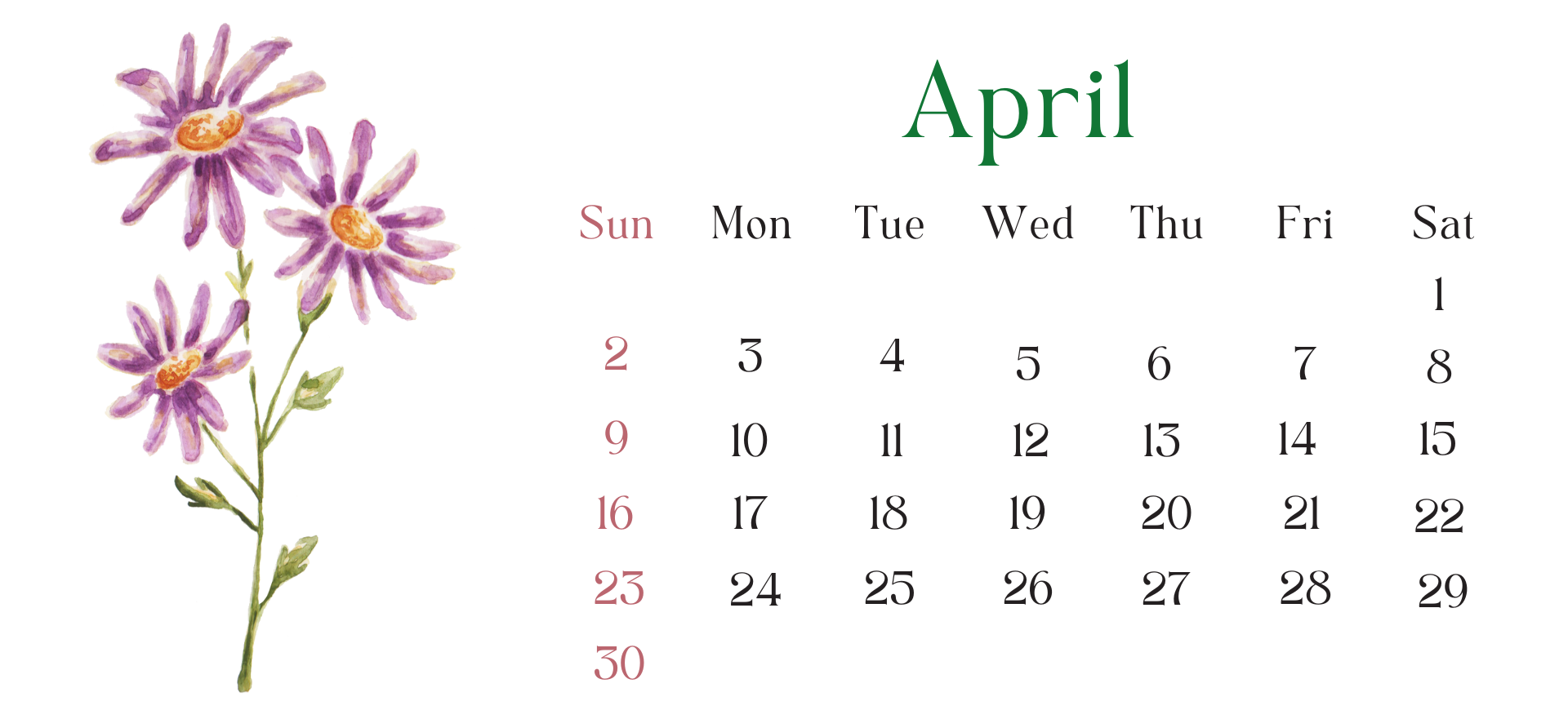
Foraging Calendar: What to Forage in April
April showers are upon us. The sky, depending on where you’re at in the world, is a bit gray and gloomy. That doesn’t mean you should stay inside.
Go outside, pop on those rain boots, and pull your raincoat on to go forage these amazing plants.
The USDA Hardiness zone Map is an attempt to divide the country into zones that give us some idea of whether certain plants can be grown in any given area. The primary piece of data used to delineate the zones is the average annual winter temperature experienced in that area. This could just be a list of forgeable plants but the temperature varies so much across the U.S.A. The Lost Herbs wants this to be a list for every one of our readers no matter the zone you live in.
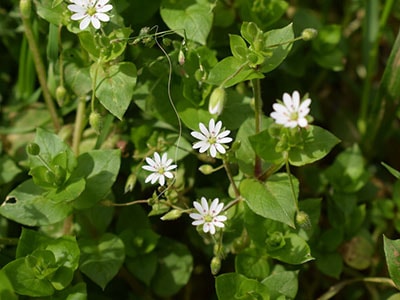 Chickweed (Stellaria media) is a low-growing herbaceous annual plant that often forms a carpet on the disturbed ground of farms, gardens, and lawns. The small, ovate simple leaves grow in an opposite branching pattern on the round, green stems. Chickweed has white flowers, which appear to have 10 petals, but it’s only five petals that are partially split. The tender leaves and stems can be eaten raw or cooked. Chickweed can also be used as an anti-itch poultice for irritated skin or eaten to relieve constipation. Chickweed grows in hardiness zones 4-11 and across the United States but is less common in the Southeast.
Chickweed (Stellaria media) is a low-growing herbaceous annual plant that often forms a carpet on the disturbed ground of farms, gardens, and lawns. The small, ovate simple leaves grow in an opposite branching pattern on the round, green stems. Chickweed has white flowers, which appear to have 10 petals, but it’s only five petals that are partially split. The tender leaves and stems can be eaten raw or cooked. Chickweed can also be used as an anti-itch poultice for irritated skin or eaten to relieve constipation. Chickweed grows in hardiness zones 4-11 and across the United States but is less common in the Southeast.
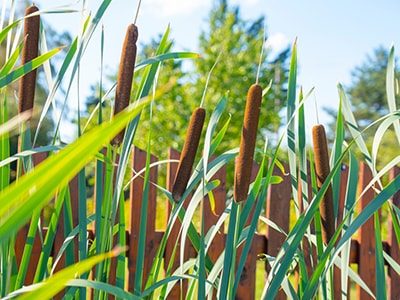 Cattails (Typha latifolia) have iconic brown seed heads that explode into a mass of ivory colored fluff (which makes for great tinder). These grass-like plants will be 3 to 9 feet tall with an oval cross section to the lower stalk. You’ll find them growing in wet conditions. The young shoots that come up in the spring are the tastiest part, resembling the flavor of cucumber, and can be eaten raw. The yellow pollen that covers the flower spike in late spring or early summer makes a flour substitute. This plant grows across the United States, in hardiness zones 3-10.
Cattails (Typha latifolia) have iconic brown seed heads that explode into a mass of ivory colored fluff (which makes for great tinder). These grass-like plants will be 3 to 9 feet tall with an oval cross section to the lower stalk. You’ll find them growing in wet conditions. The young shoots that come up in the spring are the tastiest part, resembling the flavor of cucumber, and can be eaten raw. The yellow pollen that covers the flower spike in late spring or early summer makes a flour substitute. This plant grows across the United States, in hardiness zones 3-10.
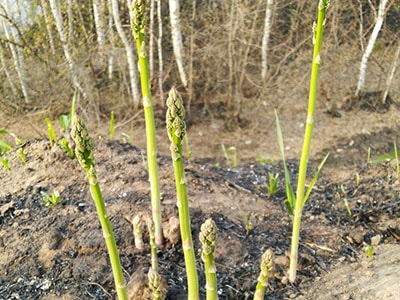 Wild Asparagus (Asparagus officinalis). The true leaves are the little triangular flap like scales that grow on the spears. The flowers grow in the junctions between the stems. They are white to yellowish green, are bell shaped and appear on their own or in small clusters. Wild asparagus can be used like the kind you buy at the store. Roasted, grilled, or raw is totally safe to eat. Wild asparagus grows in every state in the United States. It grows in hardiness zones 3-8.
Wild Asparagus (Asparagus officinalis). The true leaves are the little triangular flap like scales that grow on the spears. The flowers grow in the junctions between the stems. They are white to yellowish green, are bell shaped and appear on their own or in small clusters. Wild asparagus can be used like the kind you buy at the store. Roasted, grilled, or raw is totally safe to eat. Wild asparagus grows in every state in the United States. It grows in hardiness zones 3-8.
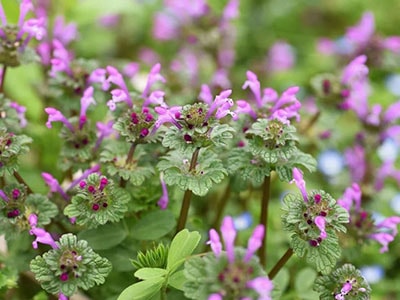 Henbit (Lamium amplexicaule). Flowers of henbit range from pink to purple, with darker purple spots than those of purple deadnettle. Henbit flowers are longer and slenderer than purple deadnettle flowers. Purple deadnettle leaves are purple at the apex of the stems and fade to green as they mature. There are long stretches of stem between the leaves, which are rounded and scalloped with a wrinkly look. Henbit can be consumed fresh or cooked as an edible herb, and it can be used in teas. The stem, flowers, and leaves are edible. It is very nutritious, high in iron, vitamins, and fiber. You can add it raw to salads, soups, wraps, or green smoothies. This plant grows across the United States except for desert regions. It grows in hardiness zones 4-8.
Henbit (Lamium amplexicaule). Flowers of henbit range from pink to purple, with darker purple spots than those of purple deadnettle. Henbit flowers are longer and slenderer than purple deadnettle flowers. Purple deadnettle leaves are purple at the apex of the stems and fade to green as they mature. There are long stretches of stem between the leaves, which are rounded and scalloped with a wrinkly look. Henbit can be consumed fresh or cooked as an edible herb, and it can be used in teas. The stem, flowers, and leaves are edible. It is very nutritious, high in iron, vitamins, and fiber. You can add it raw to salads, soups, wraps, or green smoothies. This plant grows across the United States except for desert regions. It grows in hardiness zones 4-8.
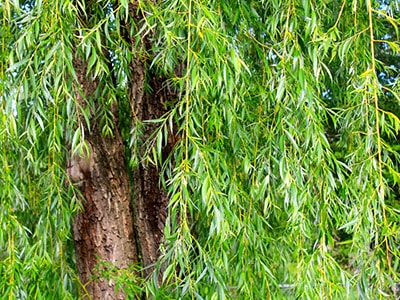 Willow (Salix alba) can appear silvery-white due to the color of the undersides of its silky, narrow leaves. It has upswept branches and often leans. It can be distinguished from Crack willow by its shorter leaves with hairy undersides. Consuming tea from willow bark has pain relieving qualities similar to aspirin since they share similar compounds. Willow can also be used to make hand crafted instruments such as a flute. Willows grow best east of the Mississippi River, though some varieties have strayed their way down to the Midwest, Texas, Oklahoma, and even parts of Central and Southern California. White willow grows in hardiness zones 3-8.
Willow (Salix alba) can appear silvery-white due to the color of the undersides of its silky, narrow leaves. It has upswept branches and often leans. It can be distinguished from Crack willow by its shorter leaves with hairy undersides. Consuming tea from willow bark has pain relieving qualities similar to aspirin since they share similar compounds. Willow can also be used to make hand crafted instruments such as a flute. Willows grow best east of the Mississippi River, though some varieties have strayed their way down to the Midwest, Texas, Oklahoma, and even parts of Central and Southern California. White willow grows in hardiness zones 3-8.
⇒ How to Make Bark Bread from a Tree That Grows on Almost Every Street in America (Video)
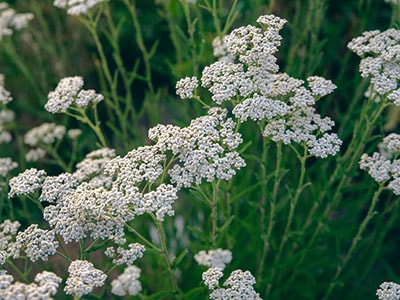 Yarrow (Achillea millefolium) Wild yarrow typically has white or pink flowers, but cultivated yarrow can have yellow, orange, pink or red flowers. Yarrow stems are grooved and have small woolly hairs. Yarrow is useful for multiple ailments, such as fever, common cold, hay fever, absence of menstruation, dysentery, diarrhea, loss of appetite, gastrointestinal tract discomfort, and to induce sweating. Some people chew fresh leaves to relieve a toothache. Yarrow is found across the United States. It grows in hardiness zone 3-9.
Yarrow (Achillea millefolium) Wild yarrow typically has white or pink flowers, but cultivated yarrow can have yellow, orange, pink or red flowers. Yarrow stems are grooved and have small woolly hairs. Yarrow is useful for multiple ailments, such as fever, common cold, hay fever, absence of menstruation, dysentery, diarrhea, loss of appetite, gastrointestinal tract discomfort, and to induce sweating. Some people chew fresh leaves to relieve a toothache. Yarrow is found across the United States. It grows in hardiness zone 3-9.
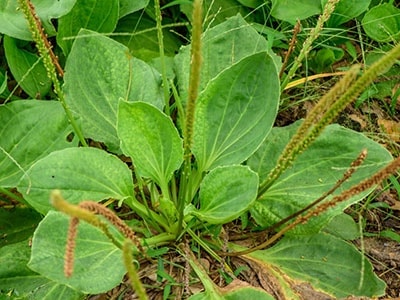 Plantain (Plantago major) grows low to the ground and has distinctive leaves with prominent parallel veins. These leaves grow in a basal rosette, which means they grow at the base of the plant, the leaves overlapping to loosely form a rose-like shape. Plantain is also identifiable by its prominent central flower spike. The leaves are primarily used as medicine, but the seeds can also be utilized as a laxative. Plantain can be used to soothe bronchitis, burns, coughs, dermatitis, insect bites and stings, peptic ulcers, urinary tract infection and wounds. The young, tender leaves can be eaten raw, and the older, stringier leaves can be boiled in stews. The seeds are also edible. It grows in the Eastern and Central United States. Plantains grow in hardiness zone 3-12.
Plantain (Plantago major) grows low to the ground and has distinctive leaves with prominent parallel veins. These leaves grow in a basal rosette, which means they grow at the base of the plant, the leaves overlapping to loosely form a rose-like shape. Plantain is also identifiable by its prominent central flower spike. The leaves are primarily used as medicine, but the seeds can also be utilized as a laxative. Plantain can be used to soothe bronchitis, burns, coughs, dermatitis, insect bites and stings, peptic ulcers, urinary tract infection and wounds. The young, tender leaves can be eaten raw, and the older, stringier leaves can be boiled in stews. The seeds are also edible. It grows in the Eastern and Central United States. Plantains grow in hardiness zone 3-12.
While all of these are located in America, we don’t want to leave our overseas readers out of the loop. Countries like Canada and Australia are also abundant with delicious plants.
Canada’s weather aligns more with the United States and many of the plants above can grow in Canada’s ecosystem. Canadians can use the hardiness zones to apply to their regions.
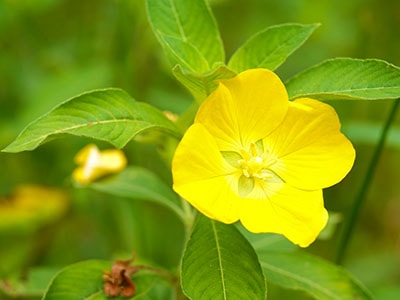 Common Evening-Primrose (Oenothera biennis) Grows to about 0.5-1.5m in height with a hairy stem. The leaves are slightly toothed at margins and attached directly to the stem. It has a leafy spike of large yellow flowers at the top of the plant. The roots are edible and said to resemble those of the salsify plant, both in its appearance and their parsnip-like taste. Young shoots have a peppery flavor and should be used sparingly. Cooked roots can be fried, pickled, roasted, and served as a side dish, added to soups and stews or candied in syrup. Young leaves, flower buds, and green pods can all be used in salads or boiled like other leafy greens (be sure to change the water several times). Evening-Primose grows in hardiness zones 4-9.
Common Evening-Primrose (Oenothera biennis) Grows to about 0.5-1.5m in height with a hairy stem. The leaves are slightly toothed at margins and attached directly to the stem. It has a leafy spike of large yellow flowers at the top of the plant. The roots are edible and said to resemble those of the salsify plant, both in its appearance and their parsnip-like taste. Young shoots have a peppery flavor and should be used sparingly. Cooked roots can be fried, pickled, roasted, and served as a side dish, added to soups and stews or candied in syrup. Young leaves, flower buds, and green pods can all be used in salads or boiled like other leafy greens (be sure to change the water several times). Evening-Primose grows in hardiness zones 4-9.
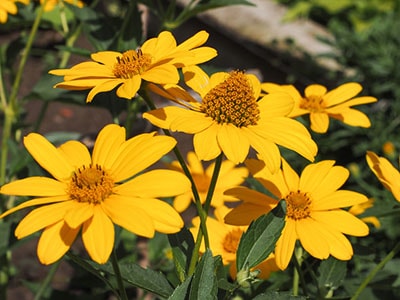 Sunchokes (Helianthus tuberosus). Jerusalem artichoke, also known as Sunchoke, is a perennial plant that reproduces by seed and by fleshy rhizomes which bear small, potato-like tubers. The stems are stout, 1-3 meters in height, and become woody over time. The leaves are simple, rough-hairy, oval to lance shaped, with coarsely toothed edges. The flower heads are bright yellow and resemble a sunflower but are smaller. Jerusalem artichokes taste slightly nutty and savory – like a cross between an artichoke heart and a potato. Unlike regular potatoes, Jerusalem artichoke tubers are not affected by freezing and thawing. Sunchokes grow in hardiness zones 3-8.
Sunchokes (Helianthus tuberosus). Jerusalem artichoke, also known as Sunchoke, is a perennial plant that reproduces by seed and by fleshy rhizomes which bear small, potato-like tubers. The stems are stout, 1-3 meters in height, and become woody over time. The leaves are simple, rough-hairy, oval to lance shaped, with coarsely toothed edges. The flower heads are bright yellow and resemble a sunflower but are smaller. Jerusalem artichokes taste slightly nutty and savory – like a cross between an artichoke heart and a potato. Unlike regular potatoes, Jerusalem artichoke tubers are not affected by freezing and thawing. Sunchokes grow in hardiness zones 3-8.
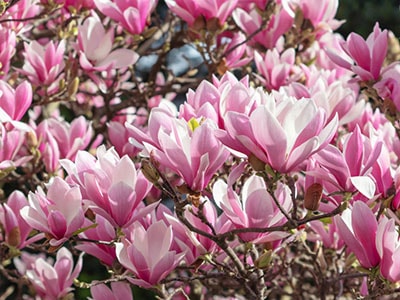 Magnolia (Magnolia x soulangiana). The simple and deciduous leaves of the Saucer Magnolia are a dark green color in the summer with a smooth, leathery texture, but turn into a bronze, gold color during the fall. It’s abundant in urban settings and easy to spot and harvest. The petals are somewhat floral with mild notes of ginger, cloves or black pepper. You can eat them raw, but they are better pickled as a condiment for everything from rice bowls to burger toppings. Magnolia grows in hardiness zones 4-9.
Magnolia (Magnolia x soulangiana). The simple and deciduous leaves of the Saucer Magnolia are a dark green color in the summer with a smooth, leathery texture, but turn into a bronze, gold color during the fall. It’s abundant in urban settings and easy to spot and harvest. The petals are somewhat floral with mild notes of ginger, cloves or black pepper. You can eat them raw, but they are better pickled as a condiment for everything from rice bowls to burger toppings. Magnolia grows in hardiness zones 4-9.
Australia lies in Plant Hardiness Zones 7 through 12 with some variations across regions and seasons. The caveat with foraging in Australia is it’s completely illegal without a permit, except private properties, in some places. Without the 104$ permit you can be fined anywhere from 10,000 to 110,000 dollars depending on where you foraged. If you have a license or are on your own land you can forage freely.
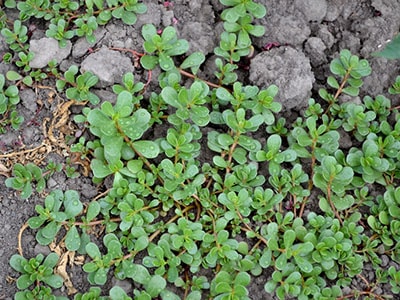 Purslane (Portulaca oleracea) leaves are succulent and grow in an alternate fashion on the stem which is thick and reddish in color. It is one of the few vegetables that’s rich in omega-3 fatty acids, which are important to support healthy arteries and can help prevent strokes, heart attacks, and other forms of heart disease. In fact, purslane has the highest-recorded levels of omega-3 fatty acids of any land-based plant. Purslane grows in hardiness zones 6-10. Be wary of its look-a-like, Spurges; they are poisonous. Spurges exude a white latex when broken. These plants grow in hardiness zones 8-10.
Purslane (Portulaca oleracea) leaves are succulent and grow in an alternate fashion on the stem which is thick and reddish in color. It is one of the few vegetables that’s rich in omega-3 fatty acids, which are important to support healthy arteries and can help prevent strokes, heart attacks, and other forms of heart disease. In fact, purslane has the highest-recorded levels of omega-3 fatty acids of any land-based plant. Purslane grows in hardiness zones 6-10. Be wary of its look-a-like, Spurges; they are poisonous. Spurges exude a white latex when broken. These plants grow in hardiness zones 8-10.
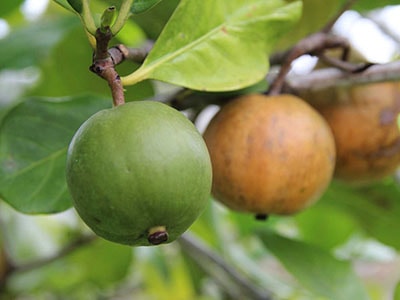 Native Gardenia (Atractocarpus fitzalanii). Common small tree found in tropical and sub-tropical forest in Far North Queensland to Mackay which grows to 5-8 m. The trunk has smooth, grey bark. Flowers are fragrant and white from September to November, with five petals with different sized male and female flowers. Fruits are yellow with many flat, triangular, whitish small seeds embedded in a rather dry pulp, which ripens late summer to midwinter and it’s edible when soft. This plant grows in zones 8-11.
Native Gardenia (Atractocarpus fitzalanii). Common small tree found in tropical and sub-tropical forest in Far North Queensland to Mackay which grows to 5-8 m. The trunk has smooth, grey bark. Flowers are fragrant and white from September to November, with five petals with different sized male and female flowers. Fruits are yellow with many flat, triangular, whitish small seeds embedded in a rather dry pulp, which ripens late summer to midwinter and it’s edible when soft. This plant grows in zones 8-11.
Have you picked any of these in the past springs? Let us know what your favorites are to forage this time of year in the comments!








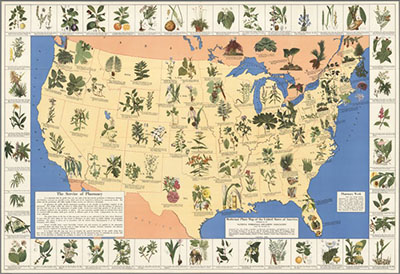

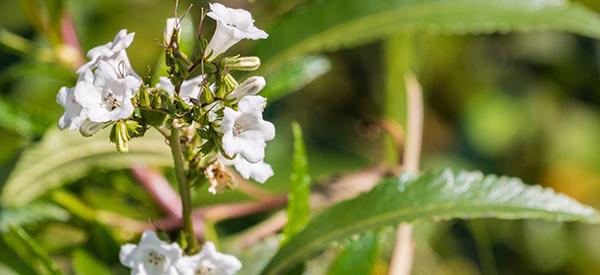

Thank you so much for sharing this information! As soon as the snow is gone here in northern Utah along the Wasatch front I am heading out to forage! This list and pictures will be helpful!
I live in Zone 4a and have purslane all over my garden. It is truly a lovely plant to have around.
Me too, in live in zone 4 and see tons of this growing everywhere!
I always considered purslane a weed. I don’t eat it and I don’t know what else to do with it. I do snack on some of the leaves when I’m working in the garden, but convincing anyone else to eat it in a salad or such wouldn’t work in my family. I guess any plant’s a weed if it’s in the wrong place, right? My mother said they called it “pig weed” when she was a child because they would feed it to the pigs. Healthy pigs!
Hi Rudy,
Thank you so much for taking the time to share this story with us! We really appreciate it!
Many blessings and good health!
I live in Australia and didn’t know it was illegal to forage. Thousands of us have been foraging for mushrooms and blackberries at least since I was a girl 70 years ago.